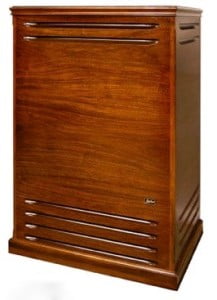In a previous post I outlined how to get a line level from a Hammond tonewheel organ. The next step in the chain is to get a Leslie simulation going to get the raw Hammond sound transformed into the sound we all know and love – the Hammond and Leslie combination.
I’ve experimented with two alternative approaches, one using hardware in the form of a Leslie simulator pedal (in this case a Neo Ventilator II), and one using software, going through an interface into a Macbook Pro.
Using the Neo Vent is easy, just plug in the (padded) line out into the Vent, twiddle knobs to your liking, and you have a stereo line out that adds the Leslie simulation to the sound. The Neo Vent simulates the effect of a recorded Leslie, and the result is very good. You can either feed a mixing desk with the signal, and take your headphones out from there, or use a headphone amp to drive your headphones directly for ‘silent’ use. You can also take it into your computer through an interface, and apply other effects as desired, and record with it directly as well.
The second option takes the line out from the Hammond to an audio interface (my CI2+) that makes the signal available to a computer. Line level is less of an issue here because most interfaces let you trim the level of the input signal down to a usable level. I use a Macbook Pro to host DAWs – you can use Garageband (both for just listening and for recording), Logic (same, but with more control over the recording aspects), or Mainstage (very good for live playing, but not that great for recording, although there are some basic functions to do so). Garageband comes free with your Mac, so that is the cheaper option, but it has some limitations.
All applications mentioned make it easy to use plugins, from compressors to equalisers to overdrive and Leslie-simulators, and even amp modeling if you’re looking for that massive distorted drive.
Two plug-ins are of particular interest: the Spin Control pedalboard control and the Rotor plugin.
The Spin Control offers basic Leslie modeling, with a choice of Leslie types, control over acceleration, slow and fast speed, and drive. It generates a nice Leslied signal, from clean to quite aggressive overdriven sounds.
The Rotor plug-in is just that, a very clean rotor emulation, with a choice of Leslie types and mike positions. It gives a very clean emulation without and growl or distortion; this can be added by using an overdrive plugin before the rotor. The rotor on its own drops the output volume down quite a bit, it is probably anticipating to be used with a (loud) overdrive stage and/ or amp stage in front of it.
For a mildly saturated every-day Leslie sound, I like the Spin Control the most; the rotor is usable for very hard overdrive situation beyond what Spin Control can handle
On Garageband, no midi-based automation is possible, so you cannot use a pedal to steer the chorale / tremolo switching in real time, but adding the modulation in later is possible through automation.
Logic does have the possibility to use midi-based triggering, and you can set up a pedal or button to handle Leslie switching in real-time. I’m still trying to figure out how to implement latching, but push-to-fast, slow when released works very well out of the box.
Mainstage has an easier way of setting up latching or non-latching use of pedals and buttons and is more geared towards pure live playing, and does this very well, but lacks in recording features. It also features the Spin Control and the Rotor plugin.
So what works best? I like the sound I get from the Spin Control, feeding in the Hammond line-out directly; it has a more edgy, more saturated sound than the Neo Ventilator, which makes is well suited for Rock, Funk and Pop. The Vent excels at the traditional jazzy Leslie sound. I sometimes use the Rotor in extreme ‘Jon Lord’ type settings, but find it otherwise too cold to be of much use, but for recording, the Spin Control is my go-to solution for that Hammond and Leslie sound for now.
Edit – the Vent is really growing on me, and gets a much warmer drive going when you push it hard. It’s essential to feed it a signal that is of just the right level, just before the vent’s red light starts clipping. Don’t use the soft setting on the Hammond, this takes off some of the edge. This gives a very good tone that responds to the pedal well when dialled in properly. And you can use a real Leslie switch…

 Jut added an
Jut added an 